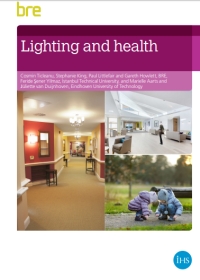Lighting and health FB 74
BRE (Building Research Establishment) is an independent, research-based consultancy, testing and training organisation, operating in the built environment and associated industries.
Lighting and health (FB 74) was written by Cosmin Ticleanu, Stephanie King, Paul Littlefair and Gareth Howlett, BRE, Feride ener Yilmaz, Istanbul Technical University, and Marielle Aarts and Jüliette van Duijnhoven, Eindhoven University of Technology. It was published by BRE on 7 August 2015.
Lighting can affect the health of people in buildings. This goes beyond the safety aspects of providing enough illumination to see by; lighting affects mood and human circadian rhythms. Poor lighting can cause glare, headaches, eyestrain, skin conditions and various types of sight loss. It is important for designers, building owners and occupants to be aware of these issues.
A substantial amount of research has been carried out in this area, and this 64-page report reviews that research, asking easy-to-understand questions such as: Can LEDs keep you awake at night and damage your brain? Can special lighting help people with dementia? and so on.
The report concludes with guidance for lighting designers, building occupants and building managers, helping them maximise the health benefits of lighting and minimise the health risks.
The contents of the report are:
- Acronyms.
- Executive summary.
- Safe, healthy lighting for tasks.
- Circadian and seasonal rhythms.
- Optical hazards.
- Light exposure to skin.
- Indirect impacts.
- Special types of lighting.
- Recommendations.
- References.
- Further reading.
[edit] Related articles on Designing Buildings Wiki
- 7 ways better lighting can improve your health.
- BRE articles on Designing Buildings Wiki.
- BRE Buzz articles on Designing Buildings Wiki.
- BRE Buzz.
- BRE Expert Collection 6 Daylight and shading.
- BREEAM External lighting.
- BREEAM Internal and external lighting.
- BREEAM Reduction of night time light pollution.
- BREEAM Visual comfort Daylighting.
- Building Research Establishment.
- Circadian rhythms.
- Daylight benefits in healthcare buildings.
- Health and wellbeing impacts of natural and artificial lighting.
- Lighting and health infographic.
- Lighting for circadian rhythms.
- Use of lighting to improve health and wellbeing.
Featured articles and news
Latest Build UK Building Safety Regime explainer published
Key elements in one short, now updated document.
UKGBC launch the UK Climate Resilience Roadmap
First guidance of its kind on direct climate impacts for the built environment and how it can adapt.
CLC Health, Safety and Wellbeing Strategy 2025
Launched by the Minister for Industry to look at fatalities on site, improving mental health and other issues.
One of the most impressive Victorian architects. Book review.
Common Assessment Standard now with building safety
New CAS update now includes mandatory building safety questions.
RTPI leader to become new CIOB Chief Executive Officer
Dr Victoria Hills MRTPI, FICE to take over after Caroline Gumble’s departure.
Social and affordable housing, a long term plan for delivery
The “Delivering a Decade of Renewal for Social and Affordable Housing” strategy sets out future path.
A change to adoptive architecture
Effects of global weather warming on architectural detailing, material choice and human interaction.
The proposed publicly owned and backed subsidiary of Homes England, to facilitate new homes.
How big is the problem and what can we do to mitigate the effects?
Overheating guidance and tools for building designers
A number of cool guides to help with the heat.
The UK's Modern Industrial Strategy: A 10 year plan
Previous consultation criticism, current key elements and general support with some persisting reservations.
Building Safety Regulator reforms
New roles, new staff and a new fast track service pave the way for a single construction regulator.
Architectural Technologist CPDs and Communications
CIAT CPD… and how you can do it!
Cooling centres and cool spaces
Managing extreme heat in cities by directing the public to places for heat stress relief and water sources.
Winter gardens: A brief history and warm variations
Extending the season with glass in different forms and terms.
Restoring Great Yarmouth's Winter Gardens
Transforming one of the least sustainable constructions imaginable.
























